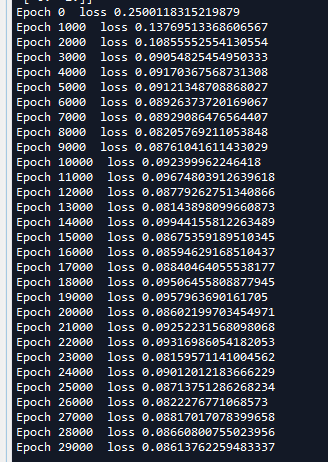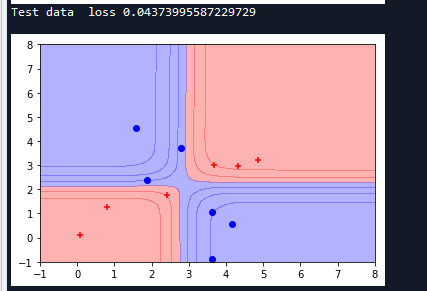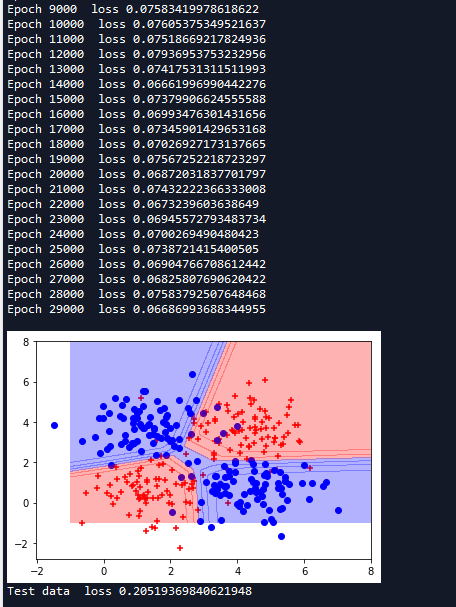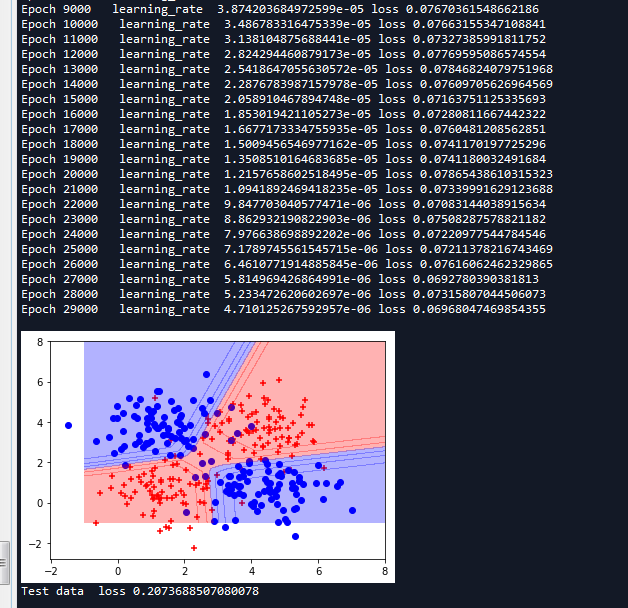随着科研人员在使用神经网络训练时不断的尝试,为我们留下了很多有用的技巧,合理的运用这些技巧可以使自己的模型得到更好的拟合效果。
一 利用异或数据集演示过拟合
全连接网络虽然在拟合问题上比较强大,但太强大的拟合效果也带来了其它的麻烦,这就是过拟合问题。
首先我们看一个例子,这次将原有的4个异或带护具扩充成了上百个具有异或特征的数据集,然后通过全连接网络将它们进行分类。
实例描述:构建异或数据集模拟样本,在构建一个简单的多层神经网络来拟合其样本特征,观察其出现前泥河的现象,接着通过增大网络复杂性的方式来优化欠拟合问题,使其出现过拟合现象。
1. 构建异或数据集
''' 生成随机数据 ''' np.random.seed(10) #特征个数 num_features = 2 #样本个数 num_samples = 320 #n返回长度为特征的数组 正太分布 mean = np.random.randn(num_features) print('mean',mean) cov = np.eye(num_features) print('cov',cov) X,Y = generate(num_samples,mean,cov,[[3.0,0.0],[3.0,3.0],[0.0,3.0]],num_classes=4) #转换为二种类别 Y = Y % 2 xr = [] xb = [] for (l,k) in zip(Y[:],X[:]): if l == 0.0: xr.append([k[0],k[1]]) else: xb.append([k[0],k[1]]) xr = np.array(xr) xb = np.array(xb) plt.scatter(xr[:,0],xr[:,1],c='r',marker='+') plt.scatter(xb[:,0],xb[:,1],c='b',marker='o')

可以看到图上数据分为两类,左上和左下是一类,右上和右下是一类。
2 定义网络模型
''' 定义变量 ''' #学习率 learning_rate = 1e-4 #输入层节点个数 n_input = 2 #隐藏层节点个数 n_hidden = 2 #输出节点数 n_label = 1 input_x = tf.placeholder(tf.float32,[None,n_input]) input_y = tf.placeholder(tf.float32,[None,n_label]) ''' 定义学习参数 h1 代表隐藏层 h2 代表输出层 ''' weights = { 'h1':tf.Variable(tf.truncated_normal(shape=[n_input,n_hidden],stddev = 0.01)), #方差0.1 'h2':tf.Variable(tf.truncated_normal(shape=[n_hidden,n_label],stddev=0.01)) } biases = { 'h1':tf.Variable(tf.zeros([n_hidden])), 'h2':tf.Variable(tf.zeros([n_label])) } ''' 定义网络模型 ''' #隐藏层 layer_1 = tf.nn.relu(tf.add(tf.matmul(input_x,weights['h1']),biases['h1'])) #代价函数 y_pred = tf.nn.sigmoid(tf.add(tf.matmul(layer_1, weights['h2']),biases['h2'])) loss = tf.reduce_mean(tf.square(y_pred - input_y)) train = tf.train.AdamOptimizer(learning_rate).minimize(loss)
3. 训练网络并可视化显示
''' 开始训练 ''' training_epochs = 30000 sess = tf.InteractiveSession() #初始化 sess.run(tf.global_variables_initializer()) for epoch in range(training_epochs): _,lo = sess.run([train,loss],feed_dict={input_x:X,input_y:np.reshape(Y,[-1,1])}) if epoch % 1000 == 0: print('Epoch {0} loss {1}'.format(epoch,lo)) ''' 数据可视化 ''' nb_of_xs = 200 xs1 = np.linspace(-1,8,num = nb_of_xs) xs2 = np.linspace(-1,8,num = nb_of_xs) #创建网格 xx,yy = np.meshgrid(xs1,xs2) #初始化和填充 classfication plane classfication_plane = np.zeros([nb_of_xs,nb_of_xs]) for i in range(nb_of_xs): for j in range(nb_of_xs): #计算每个输入样本对应的分类标签 classfication_plane[i,j] = sess.run(y_pred,feed_dict={input_x:[[xx[i,j],yy[i,j]]]}) #创建 color map用于显示 cmap = ListedColormap([ colorConverter.to_rgba('r',alpha = 0.30), colorConverter.to_rgba('b',alpha = 0.30), ]) #显示各个样本边界 plt.contourf(xx,yy,classfication_plane,cmap = cmap) plt.show()


可以看到,模型在迭代训练20000次之后梯度更新就放缓了,而且loss值约等于16%并且准确率不高,所可视化的图片也没有将数据完全分开。
图上这种现象就叫做欠拟合,即没有完全拟合到想要得到的真实数据情况。
4 修正模型提高拟合度
欠拟合的原因并不是模型不行,而是我们的学习方法无法更精准地学习到适合的模型参数。模型越薄弱,对训练的要求就越高。但是可以采用增加节点或者增加层的方式,让模型具有更高的拟合性,从而降低模型的训练难度。
将隐藏层的节点个数改为200,代码如下:
#隐藏层节点个数 n_hidden = 200

从图中可以看到强大的全连接网络,仅仅通过一个隐藏层,使用200个神经元就可以把数据划分的那么细致。而loss值也在逐渐变小,30000次之后已经变成了0.056.
5 验证过拟合
那么对于上面的模型好不好呢?我们再取少量的数据放到模型中验证一下,然后用同样的方式在坐标系中可视化。
''' 测试 可以看到测试集loss值和训练集loss差距较大 这是因为模型过拟合了 ''' test_x,test_y = generate(12,mean,cov,[[3.0,0.0],[3.0,3.0],[0.0,3.0]],num_classes=4) #转换为二种类别 test_y = test_y % 2 xr = [] xb = [] for (l,k) in zip(test_y[:],test_x[:]): if l == 0.0: xr.append([k[0],k[1]]) else: xb.append([k[0],k[1]]) xr = np.array(xr) xb = np.array(xb) plt.figure() plt.scatter(xr[:,0],xr[:,1],c='r',marker='+') plt.scatter(xb[:,0],xb[:,1],c='b',marker='o') lo = sess.run(loss,feed_dict={input_x:test_x,input_y:np.reshape(test_y,[-1,1])}) print('Test data loss {0}'.format(lo)) nb_of_xs = 200 xs1 = np.linspace(-1,8,num = nb_of_xs) xs2 = np.linspace(-1,8,num = nb_of_xs) #创建网格 xx,yy = np.meshgrid(xs1,xs2) #初始化和填充 classfication plane classfication_plane = np.zeros([nb_of_xs,nb_of_xs]) for i in range(nb_of_xs): for j in range(nb_of_xs): #计算每个输入样本对应的分类标签 classfication_plane[i,j] = sess.run(y_pred,feed_dict={input_x:[[xx[i,j],yy[i,j]]]}) #创建 color map用于显示 cmap = ListedColormap([ colorConverter.to_rgba('r',alpha = 0.30), colorConverter.to_rgba('b',alpha = 0.30), ]) #显示各个样本边界 plt.contourf(xx,yy,classfication_plane,cmap = cmap) plt.show()

从这次运行结果,我们可以看到测试集的loss增加到了0.21,并没有原来训练时候的那么好0.056,模型还是原来的模型,但是这次却只框住了少量的样本。这种现象就是过拟合,它和欠拟合都是我们在训练模型中不愿意看到的现象,我们要的是真正的拟合在测试情况下能够变现出训练时的良好效果。
避免过拟合的方法有很多:常用的有early stopping、数据集扩展、正则化、弃权等,下面会使用这些方法来对该案例来进行优化。
6 通过正则化改善过拟合情况
Tensorflow中封装了L2正则化的函数可以直接使用:
tf.nn.l2_loss(t,name=None)
函数原型如下:
def l2_loss(t, name=None): r"""L2 Loss. Computes half the L2 norm of a tensor without the `sqrt`: output = sum(t ** 2) / 2 Args: t: A `Tensor`. Must be one of the following types: `half`, `float32`, `float64`. Typically 2-D, but may have any dimensions. name: A name for the operation (optional). Returns: A `Tensor`. Has the same type as `t`. 0-D. """ result = _op_def_lib.apply_op("L2Loss", t=t, name=name) return result
但是并没有提供L1正则化函数,但是可以自己组合:
tf.reduce_sum(tf.abs(w))
我们在代码中加入L2正则化:并设置返回参数lamda=1.6,修改代价函数如下:
loss = tf.reduce_mean(tf.square(y_pred - input_y)) + lamda * tf.nn.l2_loss(weights['h1'])/ num_samples + tf.nn.l2_loss(weights['h2']) *lamda/ num_samples


训练集的代价值从0.056增加到了0.106,但是测试集的代价值仅仅从0.21降到了0.0197,其效果并不是太明显。
7 通过增大数据集改善过拟合情况
下面再试试通过增大数据集的方法来改善过度拟合的情况,这里不再生产一个随机样本,而是每次从循环生成1000个数据。部分代码如下:
for epoch in range(training_epochs): train_x,train_y = generate(num_samples,mean,cov,[[3.0,0.0],[3.0,3.0],[0.0,3.0]],num_classes=4) #转换为二种类别 train_y = train_y % 2 _,lo = sess.run([train,loss],feed_dict={input_x:train_x,input_y:np.reshape(train_y,[-1,1])}) if epoch % 1000 == 0: print('Epoch {0} loss {1}'.format(epoch,lo))


这次测试集代价值降到了0.04,比训练集还低,泛化效果更好了。
8 通过弃权改善过拟合情况
在TensorFlow中弃权的函数原型如下:
def dropout(x,keep_prob,noise_shape=None,seed=None,name=None)
其中的参数意义如下:
- x:输入的模型节点
- keep_prob:保存率,如果为1,则代表全部进行学习,如果为0.8,则代表丢弃20%的节点,只让80%的节点参与学习。
- noise_shape:指定x中,哪些维度可以使用dropout技术。
- seed:随机选择节点的过程中随机数的种子值。
dropout改变了神经网络的结构,它仅仅是属于训练时的方法,所以一般在进行测试时要将dropout的keep_prob设置为1,代表不需要进行丢弃,否则会影响模型的正常输出。
程序中加入了弃权,并且把keep_prob设置为0.5.
''' 定义网络模型 ''' #隐藏层 layer_1 = tf.nn.relu(tf.add(tf.matmul(input_x,weights['h1']),biases['h1'])) keep_prob = tf.placeholder(dtype=tf.float32) layer_1_drop = tf.nn.dropout(layer_1,keep_prob) #代价函数 y_pred = tf.nn.sigmoid(tf.add(tf.matmul(layer_1_drop, weights['h2']),biases['h2'])) loss = tf.reduce_mean(tf.square(y_pred - input_y))
输出结果如下,可以看到加入弃权改进也并不是多大,和L2正则化效果差不多。

9 基于退化学习率dropout技术来拟合数据集
从上面结果可以看到代价值在来回波动,这主要是因为在训练后期出现了抖动现象,这表明学习率有点大了,这里我们可以添加退化学习率。
在使用优化器代码部分添加learning_rate,设置总步数为30000,每执行1000步,学习率衰减0.9,部分代码如下:
''' 定义网络模型 ''' #隐藏层 layer_1 = tf.nn.relu(tf.add(tf.matmul(input_x,weights['h1']),biases['h1'])) keep_prob = tf.placeholder(dtype=tf.float32) layer_1_drop = tf.nn.dropout(layer_1,keep_prob) #代价函数 y_pred = tf.nn.sigmoid(tf.add(tf.matmul(layer_1_drop, weights['h2']),biases['h2'])) loss = tf.reduce_mean(tf.square(y_pred - input_y)) global_step = tf.Variable(0,trainable=False) decaylearning_rate = tf.train.exponential_decay(learning_rate,global_step,1000,0.9) train = tf.train.AdamOptimizer(decaylearning_rate).minimize(loss,global_step = global_step) ''' 开始训练 ''' training_epochs = 30000 sess = tf.InteractiveSession() #初始化 sess.run(tf.global_variables_initializer()) for epoch in range(training_epochs): #执行一次train global_step变量会自加1 rate,_,lo = sess.run([decaylearning_rate,train,loss],feed_dict={input_x:train_x,input_y:np.reshape(train_y,[-1,1]),keep_prob:0.5}) if epoch % 1000 == 0: print('Epoch {0} learning_rate {1} loss {2} '.format(epoch,rate,lo))

我们可以看到学习率是衰减了,但是效果并不是很明显,代价值还是在震荡,我们可以尝试调整一些参数,是的效果更好,这是一件需要耐心的事情。
完整代码:

# -*- coding: utf-8 -*- """ Created on Thu Apr 26 15:02:16 2018 @author: zy """ ''' 通过一个过拟合的案例 来学习全网络训练中的优化技巧 比如:正则化,弃权等 ''' import tensorflow as tf import numpy as np from sklearn.utils import shuffle import matplotlib.pyplot as plt import random from matplotlib.colors import colorConverter, ListedColormap ''' 生成数据集 ''' def get_one_hot(labels,num_classes): ''' one_hot编码 args: labels : 输如类标签 num_classes:类别个数 ''' m = np.zeros([labels.shape[0],num_classes]) for i in range(labels.shape[0]): m[i][labels[i]] = 1 return m def generate(sample_size,mean,cov,diff,num_classes=2,one_hot = False): ''' 因为没有医院的病例数据,所以模拟生成一些样本 按照指定的均值和方差生成固定数量的样本 args: sample_size:样本个数 mean: 长度为 M 的 一维ndarray或者list 对应每个特征的均值 cov: N X N的ndarray或者list 协方差 对称矩阵 diff:长度为 类别-1 的list 每i元素为第i个类别和第0个类别均值的差值 [特征1差,特征2差....] 如果长度不够,后面每个元素值取diff最后一个元素 num_classes:分类数 one_hot : one_hot编码 ''' #每一类的样本数 假设有1000个样本 分两类,每类500个样本 sample_per_class = int(sample_size/num_classes) ''' 多变量正态分布 mean : 1-D array_like, of length N . Mean of the N-dimensional distribution. 数组类型,每一个元素对应一维的平均值 cov : 2-D array_like, of shape (N, N) .Covariance matrix of the distribution. It must be symmetric and positive-semidefinite for proper sampling. size:shape. Given a shape of, for example, (m,n,k), m*n*k samples are generated, and packed in an m-by-n-by-k arrangement. Because each sample is N-dimensional, the output shape is (m,n,k,N). If no shape is specified, a single (N-D) sample is returned. ''' #生成均值为mean,协方差为cov sample_per_class x len(mean)个样本 类别为0 X0 = np.random.multivariate_normal(mean,cov,sample_per_class) Y0 = np.zeros(sample_per_class,dtype=np.int32) #对于diff长度不够进行处理 if len(diff) != num_classes-1: tmp = np.zeros(num_classes-1) tmp[0:len(diff)] = diff tmp[len(diff):] = diff[-1] else: tmp = diff for ci,d in enumerate(tmp): ''' 把list变成 索引-元素树,同时迭代索引和元素本身 ''' #生成均值为mean+d,协方差为cov sample_per_class x len(mean)个样本 类别为ci+1 X1 = np.random.multivariate_normal(mean+d,cov,sample_per_class) Y1 = (ci+1)*np.ones(sample_per_class,dtype=np.int32) #合并X0,X1 按列拼接 X0 = np.concatenate((X0,X1)) Y0 = np.concatenate((Y0,Y1)) if one_hot: Y0 = get_one_hot(Y0,num_classes) #打乱顺序 X,Y = shuffle(X0,Y0) return X,Y def example_overfit(): ''' 显示一个过拟合的案例 ''' ''' 生成随机数据 ''' np.random.seed(10) #特征个数 num_features = 2 #样本个数 num_samples = 320 #n返回长度为特征的数组 正太分布 mean = np.random.randn(num_features) print('mean',mean) cov = np.eye(num_features) print('cov',cov) train_x,train_y = generate(num_samples,mean,cov,[[3.0,0.0],[3.0,3.0],[0.0,3.0]],num_classes=4) #转换为二种类别 train_y = train_y % 2 xr = [] xb = [] for (l,k) in zip(train_y[:],train_x[:]): if l == 0.0: xr.append([k[0],k[1]]) else: xb.append([k[0],k[1]]) xr = np.array(xr) xb = np.array(xb) plt.scatter(xr[:,0],xr[:,1],c='r',marker='+') plt.scatter(xb[:,0],xb[:,1],c='b',marker='o') ''' 定义变量 ''' #学习率 learning_rate = 1e-4 #输入层节点个数 n_input = 2 #隐藏层节点个数 n_hidden = 200 #设置为2则会欠拟合 #输出节点数 n_label = 1 input_x = tf.placeholder(tf.float32,[None,n_input]) input_y = tf.placeholder(tf.float32,[None,n_label]) ''' 定义学习参数 h1 代表隐藏层 h2 代表输出层 ''' weights = { 'h1':tf.Variable(tf.truncated_normal(shape=[n_input,n_hidden],stddev = 0.01)), #方差0.1 'h2':tf.Variable(tf.truncated_normal(shape=[n_hidden,n_label],stddev=0.01)) } biases = { 'h1':tf.Variable(tf.zeros([n_hidden])), 'h2':tf.Variable(tf.zeros([n_label])) } ''' 定义网络模型 ''' #隐藏层 layer_1 = tf.nn.relu(tf.add(tf.matmul(input_x,weights['h1']),biases['h1'])) #代价函数 y_pred = tf.nn.sigmoid(tf.add(tf.matmul(layer_1, weights['h2']),biases['h2'])) loss = tf.reduce_mean(tf.square(y_pred - input_y)) train = tf.train.AdamOptimizer(learning_rate).minimize(loss) ''' 开始训练 ''' training_epochs = 30000 sess = tf.InteractiveSession() #初始化 sess.run(tf.global_variables_initializer()) for epoch in range(training_epochs): _,lo = sess.run([train,loss],feed_dict={input_x:train_x,input_y:np.reshape(train_y,[-1,1])}) if epoch % 1000 == 0: print('Epoch {0} loss {1}'.format(epoch,lo)) ''' 数据可视化 ''' nb_of_xs = 200 xs1 = np.linspace(-1,8,num = nb_of_xs) xs2 = np.linspace(-1,8,num = nb_of_xs) #创建网格 xx,yy = np.meshgrid(xs1,xs2) #初始化和填充 classfication plane classfication_plane = np.zeros([nb_of_xs,nb_of_xs]) for i in range(nb_of_xs): for j in range(nb_of_xs): #计算每个输入样本对应的分类标签 classfication_plane[i,j] = sess.run(y_pred,feed_dict={input_x:[[xx[i,j],yy[i,j]]]}) #创建 color map用于显示 cmap = ListedColormap([ colorConverter.to_rgba('r',alpha = 0.30), colorConverter.to_rgba('b',alpha = 0.30), ]) #显示各个样本边界 plt.contourf(xx,yy,classfication_plane,cmap = cmap) plt.show() ''' 测试 可以看到测试集loss值和训练集loss差距较大 这是因为模型过拟合了 ''' test_x,test_y = generate(12,mean,cov,[[3.0,0.0],[3.0,3.0],[0.0,3.0]],num_classes=4) #转换为二种类别 test_y = test_y % 2 xr = [] xb = [] for (l,k) in zip(test_y[:],test_x[:]): if l == 0.0: xr.append([k[0],k[1]]) else: xb.append([k[0],k[1]]) xr = np.array(xr) xb = np.array(xb) plt.figure() plt.scatter(xr[:,0],xr[:,1],c='r',marker='+') plt.scatter(xb[:,0],xb[:,1],c='b',marker='o') lo = sess.run(loss,feed_dict={input_x:test_x,input_y:np.reshape(test_y,[-1,1])}) print('Test data loss {0}'.format(lo)) nb_of_xs = 200 xs1 = np.linspace(-1,8,num = nb_of_xs) xs2 = np.linspace(-1,8,num = nb_of_xs) #创建网格 xx,yy = np.meshgrid(xs1,xs2) #初始化和填充 classfication plane classfication_plane = np.zeros([nb_of_xs,nb_of_xs]) for i in range(nb_of_xs): for j in range(nb_of_xs): #计算每个输入样本对应的分类标签 classfication_plane[i,j] = sess.run(y_pred,feed_dict={input_x:[[xx[i,j],yy[i,j]]]}) #创建 color map用于显示 cmap = ListedColormap([ colorConverter.to_rgba('r',alpha = 0.30), colorConverter.to_rgba('b',alpha = 0.30), ]) #显示各个样本边界 plt.contourf(xx,yy,classfication_plane,cmap = cmap) plt.show() def example_l2_norm(): ''' 显利用l2范数缓解过拟合 ''' ''' 生成随机数据 ''' np.random.seed(10) #特征个数 num_features = 2 #样本个数 num_samples = 320 #n返回长度为特征的数组 正太分布 mean = np.random.randn(num_features) print('mean',mean) cov = np.eye(num_features) print('cov',cov) train_x,train_y = generate(num_samples,mean,cov,[[3.0,0.0],[3.0,3.0],[0.0,3.0]],num_classes=4) #转换为二种类别 train_y = train_y % 2 xr = [] xb = [] for (l,k) in zip(train_y[:],train_x[:]): if l == 0.0: xr.append([k[0],k[1]]) else: xb.append([k[0],k[1]]) xr = np.array(xr) xb = np.array(xb) plt.scatter(xr[:,0],xr[:,1],c='r',marker='+') plt.scatter(xb[:,0],xb[:,1],c='b',marker='o') ''' 定义变量 ''' #学习率 learning_rate = 1e-4 #输入层节点个数 n_input = 2 #隐藏层节点个数 n_hidden = 200 #设置为2则会欠拟合 #输出节点数 n_label = 1 #规范化参数 lamda = 1.6 input_x = tf.placeholder(tf.float32,[None,n_input]) input_y = tf.placeholder(tf.float32,[None,n_label]) ''' 定义学习参数 h1 代表隐藏层 h2 代表输出层 ''' weights = { 'h1':tf.Variable(tf.truncated_normal(shape=[n_input,n_hidden],stddev = 0.01)), #方差0.1 'h2':tf.Variable(tf.truncated_normal(shape=[n_hidden,n_label],stddev=0.01)) } biases = { 'h1':tf.Variable(tf.zeros([n_hidden])), 'h2':tf.Variable(tf.zeros([n_label])) } ''' 定义网络模型 ''' #隐藏层 layer_1 = tf.nn.relu(tf.add(tf.matmul(input_x,weights['h1']),biases['h1'])) #代价函数 y_pred = tf.nn.sigmoid(tf.add(tf.matmul(layer_1, weights['h2']),biases['h2'])) loss = tf.reduce_mean(tf.square(y_pred - input_y)) + lamda * tf.nn.l2_loss(weights['h1'])/ num_samples + tf.nn.l2_loss(weights['h2']) *lamda/ num_samples train = tf.train.AdamOptimizer(learning_rate).minimize(loss) ''' 开始训练 ''' training_epochs = 30000 sess = tf.InteractiveSession() #初始化 sess.run(tf.global_variables_initializer()) for epoch in range(training_epochs): _,lo = sess.run([train,loss],feed_dict={input_x:train_x,input_y:np.reshape(train_y,[-1,1])}) if epoch % 1000 == 0: print('Epoch {0} loss {1}'.format(epoch,lo)) ''' 数据可视化 ''' nb_of_xs = 200 xs1 = np.linspace(-1,8,num = nb_of_xs) xs2 = np.linspace(-1,8,num = nb_of_xs) #创建网格 xx,yy = np.meshgrid(xs1,xs2) #初始化和填充 classfication plane classfication_plane = np.zeros([nb_of_xs,nb_of_xs]) for i in range(nb_of_xs): for j in range(nb_of_xs): #计算每个输入样本对应的分类标签 classfication_plane[i,j] = sess.run(y_pred,feed_dict={input_x:[[xx[i,j],yy[i,j]]]}) #创建 color map用于显示 cmap = ListedColormap([ colorConverter.to_rgba('r',alpha = 0.30), colorConverter.to_rgba('b',alpha = 0.30), ]) #显示各个样本边界 plt.contourf(xx,yy,classfication_plane,cmap = cmap) plt.show() ''' 测试 可以看到测试集loss值和训练集loss差距较大 这是因为模型过拟合了 ''' test_x,test_y = generate(12,mean,cov,[[3.0,0.0],[3.0,3.0],[0.0,3.0]],num_classes=4) #转换为二种类别 test_y = test_y % 2 xr = [] xb = [] for (l,k) in zip(test_y[:],test_x[:]): if l == 0.0: xr.append([k[0],k[1]]) else: xb.append([k[0],k[1]]) xr = np.array(xr) xb = np.array(xb) plt.figure() plt.scatter(xr[:,0],xr[:,1],c='r',marker='+') plt.scatter(xb[:,0],xb[:,1],c='b',marker='o') lo = sess.run(loss,feed_dict={input_x:test_x,input_y:np.reshape(test_y,[-1,1])}) print('Test data loss {0}'.format(lo)) nb_of_xs = 200 xs1 = np.linspace(-1,8,num = nb_of_xs) xs2 = np.linspace(-1,8,num = nb_of_xs) #创建网格 xx,yy = np.meshgrid(xs1,xs2) #初始化和填充 classfication plane classfication_plane = np.zeros([nb_of_xs,nb_of_xs]) for i in range(nb_of_xs): for j in range(nb_of_xs): #计算每个输入样本对应的分类标签 classfication_plane[i,j] = sess.run(y_pred,feed_dict={input_x:[[xx[i,j],yy[i,j]]]}) #创建 color map用于显示 cmap = ListedColormap([ colorConverter.to_rgba('r',alpha = 0.30), colorConverter.to_rgba('b',alpha = 0.30), ]) #显示各个样本边界 plt.contourf(xx,yy,classfication_plane,cmap = cmap) plt.show() def example_add_trainset(): ''' 通过增加训练集解过拟合 ''' ''' 生成随机数据 ''' np.random.seed(10) #特征个数 num_features = 2 #样本个数 num_samples = 1000 #n返回长度为特征的数组 正太分布 mean = np.random.randn(num_features) print('mean',mean) cov = np.eye(num_features) print('cov',cov) ''' 定义变量 ''' #学习率 learning_rate = 1e-4 #输入层节点个数 n_input = 2 #隐藏层节点个数 n_hidden = 200 #设置为2则会欠拟合 #输出节点数 n_label = 1 input_x = tf.placeholder(tf.float32,[None,n_input]) input_y = tf.placeholder(tf.float32,[None,n_label]) ''' 定义学习参数 h1 代表隐藏层 h2 代表输出层 ''' weights = { 'h1':tf.Variable(tf.truncated_normal(shape=[n_input,n_hidden],stddev = 0.01)), #方差0.1 'h2':tf.Variable(tf.truncated_normal(shape=[n_hidden,n_label],stddev=0.01)) } biases = { 'h1':tf.Variable(tf.zeros([n_hidden])), 'h2':tf.Variable(tf.zeros([n_label])) } ''' 定义网络模型 ''' #隐藏层 layer_1 = tf.nn.relu(tf.add(tf.matmul(input_x,weights['h1']),biases['h1'])) #代价函数 y_pred = tf.nn.sigmoid(tf.add(tf.matmul(layer_1, weights['h2']),biases['h2'])) loss = tf.reduce_mean(tf.square(y_pred - input_y)) train = tf.train.AdamOptimizer(learning_rate).minimize(loss) ''' 开始训练 ''' training_epochs = 30000 sess = tf.InteractiveSession() #初始化 sess.run(tf.global_variables_initializer()) for epoch in range(training_epochs): train_x,train_y = generate(num_samples,mean,cov,[[3.0,0.0],[3.0,3.0],[0.0,3.0]],num_classes=4) #转换为二种类别 train_y = train_y % 2 _,lo = sess.run([train,loss],feed_dict={input_x:train_x,input_y:np.reshape(train_y,[-1,1])}) if epoch % 1000 == 0: print('Epoch {0} loss {1}'.format(epoch,lo)) ''' 测试 可以看到测试集loss值和训练集loss差距较大 这是因为模型过拟合了 ''' test_x,test_y = generate(12,mean,cov,[[3.0,0.0],[3.0,3.0],[0.0,3.0]],num_classes=4) #转换为二种类别 test_y = test_y % 2 xr = [] xb = [] for (l,k) in zip(test_y[:],test_x[:]): if l == 0.0: xr.append([k[0],k[1]]) else: xb.append([k[0],k[1]]) xr = np.array(xr) xb = np.array(xb) plt.figure() plt.scatter(xr[:,0],xr[:,1],c='r',marker='+') plt.scatter(xb[:,0],xb[:,1],c='b',marker='o') lo = sess.run(loss,feed_dict={input_x:test_x,input_y:np.reshape(test_y,[-1,1])}) print('Test data loss {0}'.format(lo)) nb_of_xs = 200 xs1 = np.linspace(-1,8,num = nb_of_xs) xs2 = np.linspace(-1,8,num = nb_of_xs) #创建网格 xx,yy = np.meshgrid(xs1,xs2) #初始化和填充 classfication plane classfication_plane = np.zeros([nb_of_xs,nb_of_xs]) for i in range(nb_of_xs): for j in range(nb_of_xs): #计算每个输入样本对应的分类标签 classfication_plane[i,j] = sess.run(y_pred,feed_dict={input_x:[[xx[i,j],yy[i,j]]]}) #创建 color map用于显示 cmap = ListedColormap([ colorConverter.to_rgba('r',alpha = 0.30), colorConverter.to_rgba('b',alpha = 0.30), ]) #显示各个样本边界 plt.contourf(xx,yy,classfication_plane,cmap = cmap) plt.show() def example_dropout(): ''' 使用弃权解过拟合 ''' ''' 生成随机数据 ''' np.random.seed(10) #特征个数 num_features = 2 #样本个数 num_samples = 320 #n返回长度为特征的数组 正太分布 mean = np.random.randn(num_features) print('mean',mean) cov = np.eye(num_features) print('cov',cov) train_x,train_y = generate(num_samples,mean,cov,[[3.0,0.0],[3.0,3.0],[0.0,3.0]],num_classes=4) #转换为二种类别 train_y = train_y % 2 xr = [] xb = [] for (l,k) in zip(train_y[:],train_x[:]): if l == 0.0: xr.append([k[0],k[1]]) else: xb.append([k[0],k[1]]) xr = np.array(xr) xb = np.array(xb) plt.scatter(xr[:,0],xr[:,1],c='r',marker='+') plt.scatter(xb[:,0],xb[:,1],c='b',marker='o') ''' 定义变量 ''' #学习率 learning_rate = 1e-4 #输入层节点个数 n_input = 2 #隐藏层节点个数 n_hidden = 200 #设置为2则会欠拟合 #输出节点数 n_label = 1 input_x = tf.placeholder(tf.float32,[None,n_input]) input_y = tf.placeholder(tf.float32,[None,n_label]) ''' 定义学习参数 h1 代表隐藏层 h2 代表输出层 ''' weights = { 'h1':tf.Variable(tf.truncated_normal(shape=[n_input,n_hidden],stddev = 0.01)), #方差0.1 'h2':tf.Variable(tf.truncated_normal(shape=[n_hidden,n_label],stddev=0.01)) } biases = { 'h1':tf.Variable(tf.zeros([n_hidden])), 'h2':tf.Variable(tf.zeros([n_label])) } ''' 定义网络模型 ''' #隐藏层 layer_1 = tf.nn.relu(tf.add(tf.matmul(input_x,weights['h1']),biases['h1'])) keep_prob = tf.placeholder(dtype=tf.float32) layer_1_drop = tf.nn.dropout(layer_1,keep_prob) #代价函数 y_pred = tf.nn.sigmoid(tf.add(tf.matmul(layer_1_drop, weights['h2']),biases['h2'])) loss = tf.reduce_mean(tf.square(y_pred - input_y)) train = tf.train.AdamOptimizer(learning_rate).minimize(loss) ''' 开始训练 ''' training_epochs = 30000 sess = tf.InteractiveSession() #初始化 sess.run(tf.global_variables_initializer()) for epoch in range(training_epochs): _,lo = sess.run([train,loss],feed_dict={input_x:train_x,input_y:np.reshape(train_y,[-1,1]),keep_prob:0.5}) if epoch % 1000 == 0: print('Epoch {0} loss {1}'.format(epoch,lo)) ''' 数据可视化 ''' nb_of_xs = 200 xs1 = np.linspace(-1,8,num = nb_of_xs) xs2 = np.linspace(-1,8,num = nb_of_xs) #创建网格 xx,yy = np.meshgrid(xs1,xs2) #初始化和填充 classfication plane classfication_plane = np.zeros([nb_of_xs,nb_of_xs]) for i in range(nb_of_xs): for j in range(nb_of_xs): #计算每个输入样本对应的分类标签 classfication_plane[i,j] = sess.run(y_pred,feed_dict={input_x:[[xx[i,j],yy[i,j]]],keep_prob:1.0}) #创建 color map用于显示 cmap = ListedColormap([ colorConverter.to_rgba('r',alpha = 0.30), colorConverter.to_rgba('b',alpha = 0.30), ]) #显示各个样本边界 plt.contourf(xx,yy,classfication_plane,cmap = cmap) plt.show() ''' 测试 可以看到测试集loss值和训练集loss差距较大 这是因为模型过拟合了 ''' test_x,test_y = generate(12,mean,cov,[[3.0,0.0],[3.0,3.0],[0.0,3.0]],num_classes=4) #转换为二种类别 test_y = test_y % 2 xr = [] xb = [] for (l,k) in zip(test_y[:],test_x[:]): if l == 0.0: xr.append([k[0],k[1]]) else: xb.append([k[0],k[1]]) xr = np.array(xr) xb = np.array(xb) plt.figure() plt.scatter(xr[:,0],xr[:,1],c='r',marker='+') plt.scatter(xb[:,0],xb[:,1],c='b',marker='o') lo = sess.run(loss,feed_dict={input_x:test_x,input_y:np.reshape(test_y,[-1,1]),keep_prob:1.0}) print('Test data loss {0}'.format(lo)) nb_of_xs = 200 xs1 = np.linspace(-1,8,num = nb_of_xs) xs2 = np.linspace(-1,8,num = nb_of_xs) #创建网格 xx,yy = np.meshgrid(xs1,xs2) #初始化和填充 classfication plane classfication_plane = np.zeros([nb_of_xs,nb_of_xs]) for i in range(nb_of_xs): for j in range(nb_of_xs): #计算每个输入样本对应的分类标签 classfication_plane[i,j] = sess.run(y_pred,feed_dict={input_x:[[xx[i,j],yy[i,j]]],keep_prob:1.0}) #创建 color map用于显示 cmap = ListedColormap([ colorConverter.to_rgba('r',alpha = 0.30), colorConverter.to_rgba('b',alpha = 0.30), ]) #显示各个样本边界 plt.contourf(xx,yy,classfication_plane,cmap = cmap) plt.show() def example_dropout_learningrate_decay(): ''' 使用弃权解过拟合 并使用退化学习率进行加速学习 ''' ''' 生成随机数据 ''' np.random.seed(10) #特征个数 num_features = 2 #样本个数 num_samples = 320 #n返回长度为特征的数组 正太分布 mean = np.random.randn(num_features) print('mean',mean) cov = np.eye(num_features) print('cov',cov) train_x,train_y = generate(num_samples,mean,cov,[[3.0,0.0],[3.0,3.0],[0.0,3.0]],num_classes=4) #转换为二种类别 train_y = train_y % 2 xr = [] xb = [] for (l,k) in zip(train_y[:],train_x[:]): if l == 0.0: xr.append([k[0],k[1]]) else: xb.append([k[0],k[1]]) xr = np.array(xr) xb = np.array(xb) plt.scatter(xr[:,0],xr[:,1],c='r',marker='+') plt.scatter(xb[:,0],xb[:,1],c='b',marker='o') ''' 定义变量 ''' #学习率 learning_rate = 1e-4 #输入层节点个数 n_input = 2 #隐藏层节点个数 n_hidden = 200 #设置为2则会欠拟合 #输出节点数 n_label = 1 input_x = tf.placeholder(tf.float32,[None,n_input]) input_y = tf.placeholder(tf.float32,[None,n_label]) ''' 定义学习参数 h1 代表隐藏层 h2 代表输出层 ''' weights = { 'h1':tf.Variable(tf.truncated_normal(shape=[n_input,n_hidden],stddev = 0.01)), #方差0.1 'h2':tf.Variable(tf.truncated_normal(shape=[n_hidden,n_label],stddev=0.01)) } biases = { 'h1':tf.Variable(tf.zeros([n_hidden])), 'h2':tf.Variable(tf.zeros([n_label])) } ''' 定义网络模型 ''' #隐藏层 layer_1 = tf.nn.relu(tf.add(tf.matmul(input_x,weights['h1']),biases['h1'])) keep_prob = tf.placeholder(dtype=tf.float32) layer_1_drop = tf.nn.dropout(layer_1,keep_prob) #代价函数 y_pred = tf.nn.sigmoid(tf.add(tf.matmul(layer_1_drop, weights['h2']),biases['h2'])) loss = tf.reduce_mean(tf.square(y_pred - input_y)) global_step = tf.Variable(0,trainable=False) decaylearning_rate = tf.train.exponential_decay(learning_rate,global_step,1000,0.9) train = tf.train.AdamOptimizer(decaylearning_rate).minimize(loss,global_step = global_step) ''' 开始训练 ''' training_epochs = 30000 sess = tf.InteractiveSession() #初始化 sess.run(tf.global_variables_initializer()) for epoch in range(training_epochs): #执行一次train global_step变量会自加1 rate,_,lo = sess.run([decaylearning_rate,train,loss],feed_dict={input_x:train_x,input_y:np.reshape(train_y,[-1,1]),keep_prob:0.5}) if epoch % 1000 == 0: print('Epoch {0} learning_rate {1} loss {2} '.format(epoch,rate,lo)) ''' 数据可视化 ''' nb_of_xs = 200 xs1 = np.linspace(-1,8,num = nb_of_xs) xs2 = np.linspace(-1,8,num = nb_of_xs) #创建网格 xx,yy = np.meshgrid(xs1,xs2) #初始化和填充 classfication plane classfication_plane = np.zeros([nb_of_xs,nb_of_xs]) for i in range(nb_of_xs): for j in range(nb_of_xs): #计算每个输入样本对应的分类标签 classfication_plane[i,j] = sess.run(y_pred,feed_dict={input_x:[[xx[i,j],yy[i,j]]],keep_prob:1.0}) #创建 color map用于显示 cmap = ListedColormap([ colorConverter.to_rgba('r',alpha = 0.30), colorConverter.to_rgba('b',alpha = 0.30), ]) #显示各个样本边界 plt.contourf(xx,yy,classfication_plane,cmap = cmap) plt.show() ''' 测试 可以看到测试集loss值和训练集loss差距较大 这是因为模型过拟合了 ''' test_x,test_y = generate(12,mean,cov,[[3.0,0.0],[3.0,3.0],[0.0,3.0]],num_classes=4) #转换为二种类别 test_y = test_y % 2 xr = [] xb = [] for (l,k) in zip(test_y[:],test_x[:]): if l == 0.0: xr.append([k[0],k[1]]) else: xb.append([k[0],k[1]]) xr = np.array(xr) xb = np.array(xb) plt.figure() plt.scatter(xr[:,0],xr[:,1],c='r',marker='+') plt.scatter(xb[:,0],xb[:,1],c='b',marker='o') lo = sess.run(loss,feed_dict={input_x:test_x,input_y:np.reshape(test_y,[-1,1]),keep_prob:1.0}) print('Test data loss {0}'.format(lo)) nb_of_xs = 200 xs1 = np.linspace(-1,8,num = nb_of_xs) xs2 = np.linspace(-1,8,num = nb_of_xs) #创建网格 xx,yy = np.meshgrid(xs1,xs2) #初始化和填充 classfication plane classfication_plane = np.zeros([nb_of_xs,nb_of_xs]) for i in range(nb_of_xs): for j in range(nb_of_xs): #计算每个输入样本对应的分类标签 classfication_plane[i,j] = sess.run(y_pred,feed_dict={input_x:[[xx[i,j],yy[i,j]]],keep_prob:1.0}) #创建 color map用于显示 cmap = ListedColormap([ colorConverter.to_rgba('r',alpha = 0.30), colorConverter.to_rgba('b',alpha = 0.30), ]) #显示各个样本边界 plt.contourf(xx,yy,classfication_plane,cmap = cmap) plt.show() if __name__== '__main__': #example_overfit() #example_l2_norm() #example_add_trainset() #example_dropout() example_dropout_learningrate_decay()
